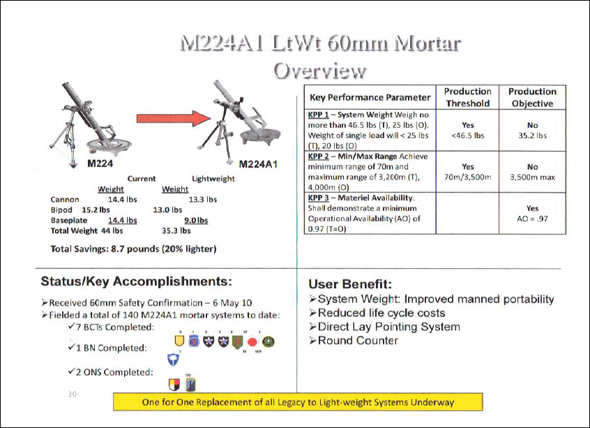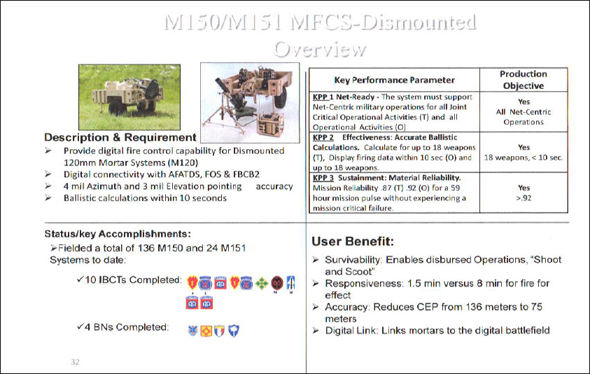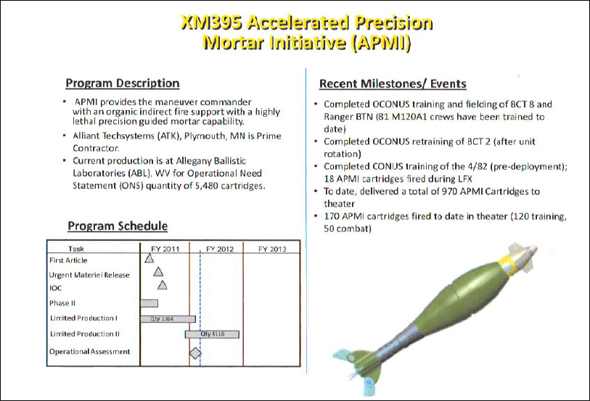Appendix J
Lethal and Nonlethal Weapons
This appendix describes current Army weapons programs that are relevant to dismounted Soldiers operating in tactical small units. Only a few of the many items discussed, primarily the individual small arms and ammunition, are contemplated to be fielded to dismounted Soldiers and infantry rifle squads. The larger crew-served mortars and machine guns typically provide support to the squad in platoon operations and are normally organic to weapons squads in the platoon.
LETHAL DIRECT FIRE SQUAD/PLATOON WEAPONS
Weapons in this category pertain to the squad and the platoon. To meet the requirements laid out in LTG Brown’s statement on desired lethal effects (see the “Lethality” heading in Chapter 2), improvements must occur in the weapon itself, the ammunition it fires, and the optics and targeting capabilities fielded to the Soldier.
The major improvements to individual and crew-served weapons to meet the lethal requirements include lighter weight, higher reliability in all environments, and higher accuracy at longer ranges. Figure J-1 illustrates the advances made in these areas over the past 10 years and what the future holds for individual categories of weapons. For all these weapons, improvements have reduced the weight, improved reliability, and increased the effective range.
Figure J-2 illustrates the recent and future planned improvements for crew-served weapons. Weight reduction, reliability improvements, and long range accuracy dominate the upgrades to crew-served weapons. Unique to this class of weapons was the elimination of the requirement to set head space and timing on the improved 50 caliber machine gun.
The improvements to individual and crew-served weapons do not end with the programs identified by the Program Executive Office (PEO) Soldier. There is a robust set of programs in the technology base that, if executed, would further reduce the weight and accuracy of these weapons. Figure J-3 is an example of one such improvement program.
In conclusion, capability gaps identified over the past ten years of conflict have led to improvements in individual and crew-served weapons that are lighter
weight, more reliable, and more accurate out to the weapons’ maximum range. In some cases, the reliability and accuracy improvements have extended the weapons’ range beyond their original baseline range.
As noted above, to ensure the Soldier has dominance in lethal effects, improvements are also needed in small caliber and medium caliber ammunition. The most recent example of what can be accomplished is the fielding of the M855A1 enhanced performance 5.56 mm round. Not only is the improved round environmentally friendly, it also has improved performance against hard targets and is extremely effective against a wide variety of targets. With the successful development of this round, the Army intends to continue to improve other calibers in the near future. Unfortunately, much of this small caliber research is unfunded at present, and the projected budget cuts for the Department of Defense (DoD) will only exacerbate the difficulty in implementing these potential improvements.
The third prong in the Army’s approach for improving lethality for the dismounted Soldier is to improve optics and targeting technologies. As with the first two elements of the program, improvements in optics and targeting during the past 10 years have enhanced the Soldier’s capabilities in combat operations. Figure J-4 illustrates the capabilities either available to the Soldier now or in development in these two areas. There are also programs in the technology base to potentially improve Soldier capabilities in optics and targeting. A few examples of these programs are the Small Arms Smart Sight Equipped Hyper Spectral Camera and the Soldier Wearable Gunfire Detection System Fusion and Networking.
In conclusion, the direct fire capabilities of squads and platoons have improved tremendously over the past 10 years. There are funded programs in both PEO Soldier and the technology base to continue to add to the dominance the U.S. warfighter enjoys in this area. The program that probably best captures the promise of the future is the Lightweight Small Arms Technology Program. The initial phase of the program is well under way with the objective of reducing the weight of the existing M249 machinegun by 35 percent and the weight of its ammunition by 40 percent, while improving lethality, reliability, maintainability, and controllability (through recoil reduction) and keeping the improved version at the equivalent cost of the existing M249.
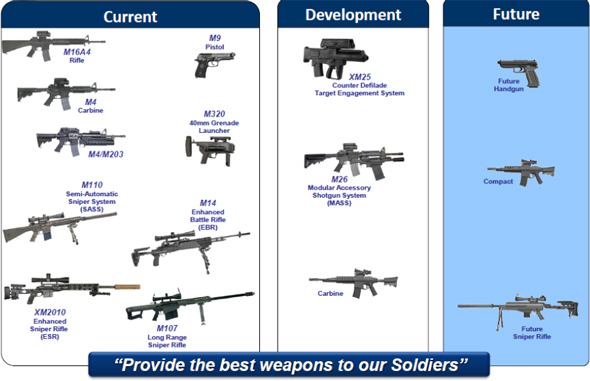
FIGURE J-1. Major improvements to individual and crew served weapons over the past 10 years. SOURCE: Brigadier General Camille Nichols, Program Executive Officer Soldier, “PEO Soldier Overview to the Board on Army Science and Technology (BAST),” presentation to the committee, June 8, 2011.
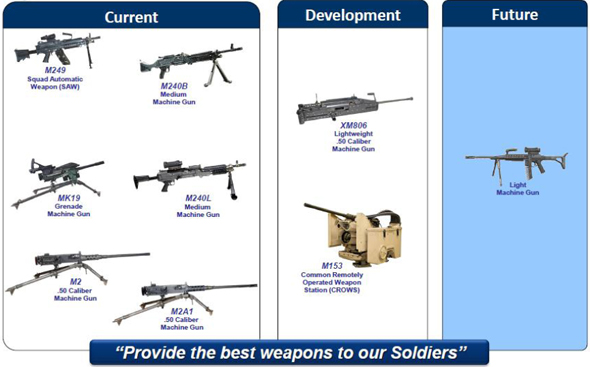
FIGURE J-2. Current and future crew-served weapons. SOURCE: Brigadier General Camille Nichols, Program Executive Officer Soldier, “PEO Soldier Overview to the Board on Army Science and Technology (BAST),” presentation to the committee, June 8, 2011.
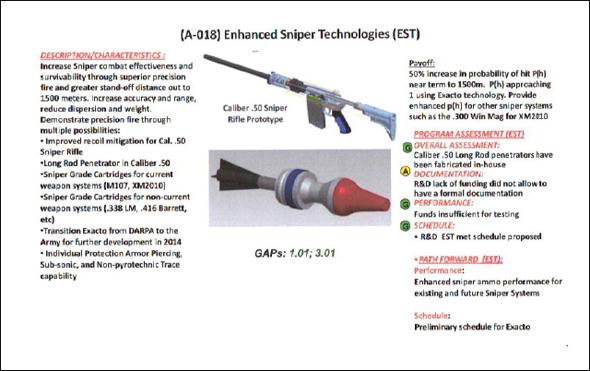
FIGURE J-3. Enhanced sniper technologies. SOURCE: Provided courtesy of the Armament Research, Development and Engineering Center (ARDEC).
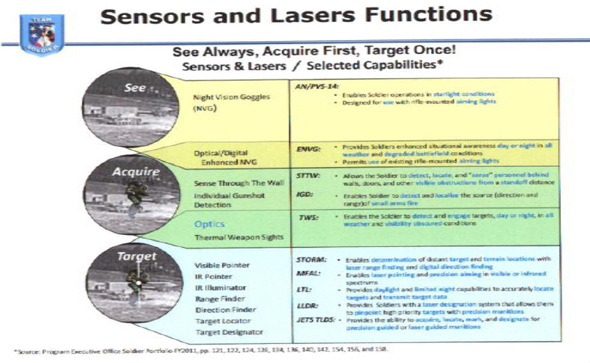
FIGURE J-4. Sensors and lasers functions. SOURCE: Brigadier General Camille Nichols, Program Executive Officer Soldier, “PEO Soldier Overview to the Board on Army Science and Technology (BAST),” presentation to the committee, June 8, 2011.
DEFILADE AND AREA FIRES
Until limited quantities of the new XM25 precision grenade launcher were introduced into the Afghanistan theater for Operation Enduring Freedom, infantry squads lacked the capability to accurately target and defeat enemy combatants protected behind walls or in other defilade positions. The standard grenade launcher and handheld grenades were available, but they do not provide the capabilities of XM25. Nicknamed the “Punisher” by Soldiers, this semiautomatic shoulder-fired weapon has a laser rangefinder and can launch a 25 mm round that explodes at a set distance. It is used to defeat enemy fighters protected by barriers such as walls, rocks, or ditches. Its range is 500 meters for precision targeting and 700 meters for area targets. The following is a quote from a Soldier in Afghanistan:
If you know anything about Afghanistan you know that the enemy likes to hide behind stuff, and we really can’t shoot through boulders and stuff like that. On the first engagement, we were engaged by PKM fire up on the OP. And what happens is you receive fire and you return fire. …
What happened was when we initially received the PKM fire, you reengage with your 240s and your M2s and your M4s, and after we figured we really weren’t getting to the enemy enough, [a Soldier] was directed to fire with the XM-25… and like I said before, the enemy likes to hide behind rocks and boulders and we really can’t shoot through stuff like that. After [the Soldier] engaged with four rounds of the XM-25, the firefight just ceased. We really couldn’t go out and do any BDA or anything like that. But you could tell that when the XM-25 brought the difference to whether they would stay there 15 or 20 minutes shooting, taking pot shots at us—where the actual fight ended after using the XM-25. That was due to the ability of the XM-25 to shoot beyond targets and behind targets.
The Army is currently deciding whether the XM-25 will become a program of record and thus a part of the weapons inventory.
The major area weapon organic to units that provide support to infantry rifle squads is the indirect fire mortar. Figure J-5 illustrates how mortars are distributed throughout the current types of infantry units.
Over the past 10 years, efforts to improve the mortar have focused on lightening components, improving the fire control process, increasing mobility of the 120 mm mortar for light, airborne, air assault, and ranger units, and developing a smart round for the 120 mm mortar. Figures J-6, J-7, and J-8 are examples of these efforts to improve mortars. Because of the importance of defilade and area fires organic to the infantry squad and their parent organizations in operations conducted in both Iraq and Afghanistan, the Army has dramatically improved capabilities in both areas. The programs to further improve the mortar support the goal of ensuring dismounted tactical small unit (TSU) overmatch in the near and mid terms. Beyond that time frame, there are numerous development programs in the technology base to
expand capabilities in both areas. The Army now has three programs that represent the technology base initiatives in defilade and area fires organic to the infantry squad and their parent organizations:
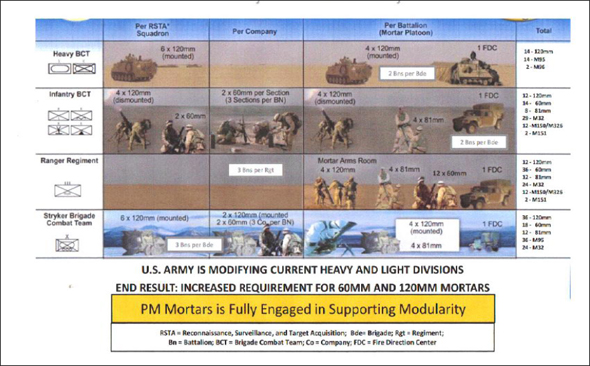
FIGURE J-5. Distribution of mortars in Army units. SOURCE: Provided courtesy of ARDEC.
• Extended range 40 mm guided projectile
• Sensor mortar network
• Precision non-line-of-sight munition technology for light forces
As long as the Army continues operations in Afghanistan, the need to improve the defilade and area fires capability of the infantry Soldier, the dismounted TSU, and supporting units will continue to have a priority. The question is whether this priority will continue, in both programs of record and the technology base, once U.S. forces depart the current areas of operations.
SUMMARY ON LETHALITY FOR THE TSU AND
SUPPORTING ECHELONS
The lethality of the infantry Soldier, squad (or future TSU), platoon, company, and infantry battalions of all types have improved dramatically in the past 10 years. If priority and budget remain focused on continuing to improve lethal capability, there are numerous programs in the technology base that can further improve lethality and help ensure the dismounted Soldier remains dominant in all operational environments where lethal force is the determining factor in decisive action.
NONLETHAL WEAPONS
Wikipedia provides the following useful characterization of nonlethal weapons:1
Nonlethal weapons, also called less-lethal weapons, less-than-lethal weapons, non-deadly weapons, compliance weapons, or pain-inducing weapons are weapons intended to be less likely to kill a living target than are conventional weapons.
Nonlethal weapons are used by the Army across the range of military operations involved in unified land operations. Military police, United Nations forces, and occupation forces use them for peacekeeping and stability operations. Nonlethal weapons may also be used to channelize a battlefield or control the movement of civilian populations.
Until the U.S. involvement in Somalia in 1993-1995, the DoD investment in nonlethal capabilities primarily mirrored the capabilities found in civil law enforcement departments and agencies. The material solutions available to Soldiers, Sailors, Marines, and Airmen were developed to support operations such as riot control, crowd control, and self-defense. The
____________________
1Additional information available at http://en.wikipedia.org/wiki/Non-lethal_weapon.
experience in Somalia led to the establishment of the DoD Non-Lethal Weapons program. The Commandant of the Marine Corps serves as the executive agent of the program. The joint component of the program conducts research on nonlethal technologies. The services’ nonlethal organizations also conduct research and are responsible for the development, procurement, and fielding of capabilities.
The tactical challenges in Iraq and Afghanistan have put a premium on the use of nonlethal weapons in both combat situations and their more traditional use in projecting force during law enforcement activities. Initially, capability gaps were met through rapid fielding of singular capabilities. In the spring of 2008, the first multipurpose nonlethal kit was fielded to U.S. Army brigades. The kits came in weatherproof compartments and consisted of five different modules designed for checkpoints, crowd control, detainee operations, convoy support, and dismounted support.
The DoD program consists of multiple service programs to develop or enhance the following nonlethal counter-personnel capabilities:
• Improved flash bang grenade
• Airburst nonlethal munition
• Long range ocular interruption
• Active denial technology
• Improved acoustic hailing device
• Underwater engagement
• MK19 nonlethal munition
• 40 mm human electromscular incapacitation projectile
• Mission payload module
• Nonlethal extended range marking munitions
• Distributed sound and light array
• Vehicle lightweight arresting device
• Single net solution and remote deployment device
• Pre-emplaced electric vehicle stopper
• Small vessel stopping entanglement
• Multi-frequency radio frequency vehicle stopper
Similar to what occurred with lethal capabilities during the past 10 years, the nonlethal area was energized by the operational environments in both Iraq and Afghanistan. The individual infantry Soldier and his units have benefited greatly from the numerous nonlethal material capabilities introduced in both theaters. The joint program and the individual services have developmental programs to further add to current capabilities. As is also the case for lethality improvements, the future of improvements in Soldier nonlethal capabilities lies in the ability of DoD to continue to fund the numerous developmental programs robustly during the near, mid, and far terms.

